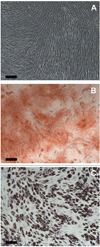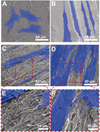Tenogenic differentiation of human MSCs induced by the topography of electrochemically aligned collagen threads
- PMID: 22177622
- PMCID: PMC3279298
- DOI: 10.1016/j.biomaterials.2011.11.066
Tenogenic differentiation of human MSCs induced by the topography of electrochemically aligned collagen threads
Abstract
Topographical cues from the extracellular microenvironment can influence cellular activity including proliferation and differentiation. Information on the effects of material topography on tenogenic differentiation of human mesenchymal stem cells (human MSCs) is limited. A methodology using the principles of isoelectric focusing has previously been developed in our laboratory to synthesize electrochemically aligned collagen (ELAC) threads that mimics the packing density, alignment and strength of collagen dense connective tissues. In the current study, human MSCs were cultured on ELAC and randomly oriented collagen threads and the effect of collagen orientation on cell morphology, proliferation and tenogenic differentiation was investigated. The results indicate that higher rates of proliferation were observed on randomly oriented collagen threads compared to ELAC threads. On the other hand, tendon specific markers such as scleraxis and tenomodulin, were significantly increased on ELAC threads compared to randomly oriented collagen threads. Additionally, osteocalcin, a specific marker of bone differentiation was suppressed on ELAC threads. Previous studies have reported that BMP-12 is a key growth factor to induce tenogenic differentiation of MSCs. To evaluate the synergistic effect of BMP-12 and collagen orientation, human MSCs were cultured on ELAC threads in culture medium supplemented with and without BMP-12. The results revealed that BMP-12 did not have an additional effect on the tenogenic differentiation of human MSCs on ELAC threads. Together, these results suggest that ELAC induces tenogenic differentiation of human MSCs by presenting an aligned and dense collagen substrate, akin to the tendon itself. In conclusion, ELAC has a significant potential to be used as a tendon replacement and in the development of an osteotendinous construct towards the regeneration of bone-tendon interfaces.
Copyright © 2011 Elsevier Ltd. All rights reserved.
Figures






Similar articles
-
Effects of phosphate-buffered saline concentration and incubation time on the mechanical and structural properties of electrochemically aligned collagen threads.Biomed Mater. 2011 Jun;6(3):035008. doi: 10.1088/1748-6041/6/3/035008. Epub 2011 May 4. Biomed Mater. 2011. PMID: 21540522 Free PMC article.
-
Bioglass incorporation improves mechanical properties and enhances cell-mediated mineralization on electrochemically aligned collagen threads.J Biomed Mater Res A. 2017 Sep;105(9):2429-2440. doi: 10.1002/jbm.a.36102. Epub 2017 May 22. J Biomed Mater Res A. 2017. PMID: 28470671
-
Tendon Tissue Engineering: Effects of Mechanical and Biochemical Stimulation on Stem Cell Alignment on Cell-Laden Hydrogel Yarns.Adv Healthc Mater. 2019 Apr;8(7):e1801218. doi: 10.1002/adhm.201801218. Epub 2019 Feb 6. Adv Healthc Mater. 2019. PMID: 30725521
-
Tendon tissue engineering: Current progress towards an optimized tenogenic differentiation protocol for human stem cells.Acta Biomater. 2022 Jun;145:25-42. doi: 10.1016/j.actbio.2022.04.028. Epub 2022 Apr 22. Acta Biomater. 2022. PMID: 35470075 Review.
-
Biomaterial Properties and Differentiation Strategies for Tenogenic Differentiation of Mesenchymal Stem Cells.Cells. 2025 Mar 18;14(6):452. doi: 10.3390/cells14060452. Cells. 2025. PMID: 40136701 Free PMC article. Review.
Cited by
-
The Lack of a Representative Tendinopathy Model Hampers Fundamental Mesenchymal Stem Cell Research.Front Cell Dev Biol. 2021 May 3;9:651164. doi: 10.3389/fcell.2021.651164. eCollection 2021. Front Cell Dev Biol. 2021. PMID: 34012963 Free PMC article. Review.
-
Mesenchymal stem cells and collagen patches for anterior cruciate ligament repair.World J Stem Cells. 2015 Mar 26;7(2):521-34. doi: 10.4252/wjsc.v7.i2.521. World J Stem Cells. 2015. PMID: 25815137 Free PMC article.
-
Constructing a highly bioactive tendon-regenerative scaffold by surface modification of tissue-specific stem cell-derived extracellular matrix.Regen Biomater. 2022 Apr 20;9:rbac020. doi: 10.1093/rb/rbac020. eCollection 2022. Regen Biomater. 2022. PMID: 35480863 Free PMC article.
-
Long-Fiber Embedded Hydrogel 3D Printing for Structural Reinforcement.ACS Biomater Sci Eng. 2022 Jan 10;8(1):303-313. doi: 10.1021/acsbiomaterials.1c00908. Epub 2021 Dec 3. ACS Biomater Sci Eng. 2022. PMID: 34860495 Free PMC article.
-
Cells Dynamically Adapt to Surface Geometry by Remodeling Their Focal Adhesions and Actin Cytoskeleton.Front Cell Dev Biol. 2022 Jun 3;10:863721. doi: 10.3389/fcell.2022.863721. eCollection 2022. Front Cell Dev Biol. 2022. PMID: 35721512 Free PMC article.
References
-
- Squier CA, Magnes C. Spatial relationships between fibroblasts during the growth of rat-tail tendon. Cell Tissue Res. 1983;234:17–29. - PubMed
-
- Fischer LP, Carret JP, Gonon GP, Sayfi Y. Arterial vascularization of the patellar ligament (ligamentum patellase) and of the Achilles tendon (tendo calcaneous) in man. Bull Assoc Anat (Nancy) 1976;60:323–334. - PubMed
-
- Krackow KA, Thomas SC, Jones LC. Ligament-tendon fixation: analysis of a new stitch and comparison with standard techniques. Orthopedics. 1988;11:909–917. - PubMed
-
- Kartus J, Movin T, Karlsson J. Donor-site morbidity and anterior knee problems after anterior cruciate ligament reconstruction using autografts. Arthroscopy. 2001;17:971–980. - PubMed
-
- Butler DL, Juncosa-Melvin N, Boivin GP, Galloway MT, Shearn JT, Gooch C, et al. Functional tissue engineering for tendon repair: A multidisciplinary strategy using mesenchymal stem cells, bioscaffolds, and mechanical stimulation. J Orthop Res. 2008;26:1–9. - PubMed
Publication types
MeSH terms
Substances
Grants and funding
LinkOut - more resources
Full Text Sources
Other Literature Sources

